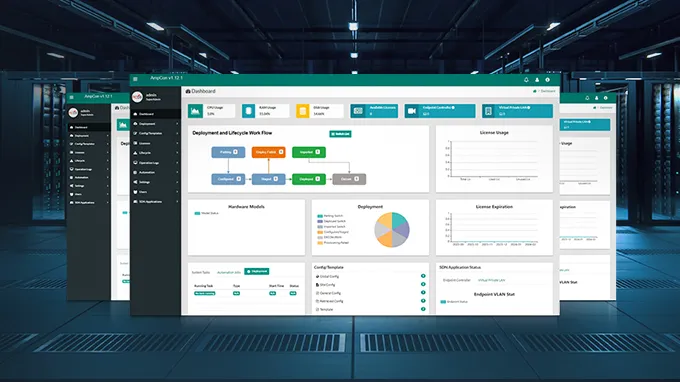How Many Types of SFP Transceivers Do You Know?
There are many 1G SFP types available today like copper RJ45 SFP, fiber optic SFP, and WDM SFP modules, so what makes them different, and how do you know which is best for you? According to different classification standards, 1G modules have different types.
By SFP Media Type
1G Ethernet SFP module can work over optical fiber and Ethernet cables, so fiber SFP module and copper SFP are the two main SFP types.
Within the fiber SFP category, there are two distinct types—single-mode SFPs, which are compatible with single-mode fibers, and multimode SFPs, which are suited for multimode fibers. These classifications correspond with the specific fiber patch cables they interface with. Refer to Table 1 for a detailed comparison of the key differences between single-mode and multimode SFP modules.
Table 1
| Specfication | Multimode SFP | Single-mode SFP |
|---|---|---|
| Fiber Type | 62.5/125µm or 50/125µm core MMF | 9/125µm core SMF |
| Working Wavelength | Mainly in 850 nm and 1300 nm | Mainly in 1310 nm and 1550 nm |
| Color Coding | Black | Blue for 1310nm SFP Yellow for 1550nm SFP |
| Transmission Distance | 100m / 550m | 2km up to 200km |
The 1000Base-T RJ45 SFP transceiver module represents a robust interface for copper-based networking, leveraging the ubiquitous twisted-pair cabling standards inclusive of Category 5e (Cat5e), Category 6 (Cat6), and the advanced Category 6a (Cat6a). This module is specially engineered to deliver high-speed gigabit connectivity across these copper mediums with an operational reach of up to 100 meters, ensuring compatibility and optimal performance in both data center architectures and enterprise LAN environments. Its design adheres to industry standards, offering a high degree of reliability and interoperability for network expansions or integrations where existing copper network infrastructure is leveraged.
By SFP Cable Core Diameter
FS has different types of 1G fiber SFP transceivers, including multi-mode, single-mode, BiDi, and WDM. For specific transmission range function details, please refer to Table 2.
Table 2
| Product |
Wavelength
|
Max. Transmit Distance |
Connector
|
|
| Multimode SFP |
850nm
|
550m |
LC Duplex
|
|
|
1310nm
|
2km |
LC Duplex
|
||
| Single mode SFP | 1000BASE-LX-31 |
1310nm
|
20km |
LC Duplex
|
| 1000BASE-LH-31 |
1310nm
|
40km |
LC Duplex
|
|
| 1000BASE-EX-55 | 1550nm | 40km |
LC Duplex
|
|
| 1000BASE-ZX-55 | 1550nm | 80km |
LC Duplex
|
|
| 1000BASE-EZX-55 | 1550nm | 120km |
LC Duplex
|
|
| 1000BASE-ZXC-55 | 1550nm | 160km |
LC Duplex
|
|
| BiDi SFP | 1000BASE-BX |
1310nm/1550nm, 1310nm/1490nm, 1510nm/1590nm
|
2km~160km |
LC Duplex/Simplex
|
| WDM SFP | 1000BASE-CWDM |
1270nm~1610nm
|
20km~160km |
LC Duplex
|
| 1000BASE-DWDM |
C17~C61
|
80km~100km |
LC Duplex
|
By SFP Operating Temperature
According to the different operating temperatures, SFP modules can usually be divided into three types:
-
Commercial grade (Commercial) : Commercial grade SFP modules are suitable for standard work environments, and their operating temperature range is usually between 0 ° C and 70 ° C. This type of SFP module performs well in ordinary office and data center environments.
-
Industrial grade (Industrial) : Industrial grade SFP modules are designed for use in more demanding industrial environments, where the operating temperature range is typically between -40 ° C and 85 ° C. This type of SFP module is suitable for industrial control systems, outdoor equipment, and other applications that require reliable operation in extreme temperature conditions.
-
Military Grade (Military) : Military grade SFP modules are designed for military applications and typically operate over a temperature range of -55 ° C to 100 ° C. This type of SFP module offers greater durability and reliability for long periods of stable operation in extreme environmental conditions.
At present, our company only provides commercial-grade and industrial-grade modules. It is very important to choose the SFP module with the appropriate operating temperature range according to actual needs and environmental conditions to ensure the stability and reliability of network equipment.
By SFP Variants
SFP transceivers come in various variants to cater to different networking requirements, including data rate, distance, wavelength, and compatibility with different types of optical fiber. Here is a brief overview of some common SFP variant types:
-
SFP: The standard SFP transceivers support speeds up to 1 Gbps and are used for Gigabit Ethernet and Fibre Channel.
-
SFP+: An enhanced version of the SFP that supports data rates up to 10 Gbps. SFP+ modules are commonly used in 10 Gigabit Ethernet and can support 8 Gbps Fibre Channel, and some variants offer Direct Attach (DAC) capabilities with copper cables.
-
SFP28: A variant that is designed for 25 Gbps Ethernet connections. This allows for higher speeds and is backwards compatible with SFP+ ports.
-
QSFP: Quad Small Form-factor Pluggable modules are not the same size as SFPs; they're wider and support four channels of data transfer, providing solutions for 40 Gbps (QSFP+) and even 100 Gbps (QSFP28) rates.
The selection of an appropriate SFP variant depends on factors including required throughput, distance the signal needs to travel, type of fiber optic cabling, and environmental conditions. It is important to match the SFP specification to the networking equipment, as well as to the operational requirements, to ensure compatibility and optimal performance. For in-depth insights into the distinctions between these advanced transceiver modules, I invite you to explore "SFP vs SFP+ vs SFP28 vs QSFP vs QSFP28: What Are the Differences?".
By SFP Application
Based on different applications, SFP types are usually categorized by the following types.
Regular SFP: Most commonly transceivers that deliver data via a duplex fiber. Based on market development and user requests, 2.5G SFP and 100M SFP have emerged successively
BIDI SFP: Can transmit and receive signals in simplex fiber.
WDM SFPs: Support CWDM/DWDM transmission to maximize the bandwidth while saving the fiber cabling.
SONET/SDH SFP: Compatible with the SONET/SDH and ATM standard which covers the standard range of data rates extending from OC-3/STM-1 (155 Mbps) to OC-48/STM-16 (2488 Gbps) for multimode (MM), short-reach (SR), intermediate-reach (IR1), and long-reach (LR1/LR2) applications.
PON SFPs: Used in the Optical Line Terminal (OLT) at the Central Office and the Optical Network Terminal/Unit (ONT/ONU) at the subscriber’s premises.
3G-SDI video SFPs: Designed to meet the high standard video transmission needs in the High Definition (HD) environment.
SONET/SDH SFP: Compatible with the SONET/SDH and ATM standard which covers the standard range of data rates extending from OC-3/STM-1 (155 Mbps) to OC-48/STM-16 (2488 Gbps) for multimode (MM), short-reach (SR), intermediate-reach (IR1), and long-reach (LR1/LR2) applications.
Fibre Channel SFP: A high-speed network technology (commonly running at 1, 2, 4, 8, 16, 32, and 128 gigabits per second rates) primarily used to connect computer data storage to servers in the SAN data center environment.
Each category serves a unique role in network architecture, with different performance metrics and standardized compliance to ensure connectivity and communication across a variety of platforms.
SFP Module Quality and After-Sale Service
Nobody can ensure the SFP modules received are 100% normal. And the service life of optical transceiver is generally 5 years among many vendors. It’s difficult to tell the quality is good or bad in the first year. Therefore, choosing a reliable SFP manufacturer that not only produces high-quality products but also backs them with exemplary after-sale service is essential for the smooth functioning of your network infrastructure.
Related articles:
You might be interested in
Email Address

-
PoE vs PoE+ vs PoE++ Switch: How to Choose?
May 30, 2024
















